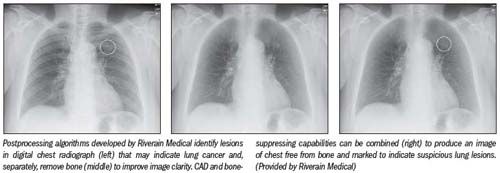Riverrain's new x-ray lung CAD features bone removal
Bone can obscure lung lesions that may indicate cancer. The latest version of computer-assisted detection software from Riverain Medical, shown publicly for the first time in the RSNA 2010 exhibit hall, takes care of the problem.
Bone can obscure lung lesions that may indicate cancer. The latest version of computer-assisted detection software from Riverain Medical, shown publicly for the first time in the RSNA 2010 exhibit hall, takes care of the problem. This version automatically identifies and then draws markers encircling suspected lung cancer nodules on digital chest radiographs from which bone, such as ribs and the clavicle, have been subtracted.
The new offering is a software hybrid of two Riverain products: CAD-based OnGuard 5.1 and the bone-suppressing SoftView. As with each separate product, the bundle works as an integral part of a PACS, requiring no separate viewing station. It also works with all digital and computed radiography systems, according to Steve Worrell, chief technology officer at Riverain Medical.
“You can have the PACS or the modality push the digital chest radiograph to OnGuard or SoftView, which [will then] introduce the imagery or the markers-or marry them together-so they are all available at the point where the radiologist reads,” Worrell said.
In offering OnGuard, SoftView, and a blend of the two, Riverain provides enough choices to satisfy a range of needs, Worrell said. SoftView offers a bone-suppressed image of the chest, which can be used for applications other than nodule detection.

“In some cases, radiologists would prefer to just have a better image, as opposed to having markers on that image,” he said.
OnGuard 5.1 identifies and marks suspicious lesions for radiologists who simply want a CAD program.
As Riverain demonstrated these two separate products, some radiologists asked why they were not combined, allowing the markers to be placed on the bone-suppressed SoftView image. And so Riverain did exactly that.
Developing the two products separately permitted the company to focus on improving the underlying capabilities of both. A fundamental weakness of CAD has been its tendency to impede rather than boost productivity.
CAD typically is used as a second read. The algorithms insert markers indicating suspicious lesions after the primary read, forcing radiologists to go back over what they have already interpreted. Embedding bone suppression in OnGuard addresses this by making the primary read easier and, potentially, faster, according to Worrell.
“Bones are an obstacle to sensitivity and specificity (when interpreting chest radiographs) because lesions can hide behind them,” he said. “To the extent that we can remove the bone, we can make reading easier and better mark those lesions, which also reduces false positives.”
The bone suppression complements a powerful CAD algorithm that, in clinical trials, proved effective at detecting lung nodules ranging from 9 to 30 mm. Research published in Radiology last year documented that the algorithm can detect up to 50% of nodules that would otherwise be missed. The company asserts that improvements in this algorithm can cut false positives by 73% compared with earlier versions of the software.
Cutting the number of false positives attacks the major stumbling block to the widespread use of CAD, Worrell said. Riverain's CAD algorithm has done this while increasing sensitivity.
“As time goes on, we will continue to enrich that marker by encoding perhaps different kinds of information to aid the radiologist in the interpretation,” Worrell said. “The objective is to constantly enrich that environment with more information.”
GE HealthCare Debuts AI-Powered Cardiac CT Device at ACC Conference
April 1st 2025Featuring enhanced low-dose image quality with motion-free images, the Revolution Vibe CT system reportedly facilitates improved diagnostic clarity for patients with conditions ranging from in-stent restenosis to atrial fibrillation.
The Reading Room Podcast: Current Perspectives on the Updated Appropriate Use Criteria for Brain PET
March 18th 2025In a new podcast, Satoshi Minoshima, M.D., Ph.D., and James Williams, Ph.D., share their insights on the recently updated appropriate use criteria for amyloid PET and tau PET in patients with mild cognitive impairment.